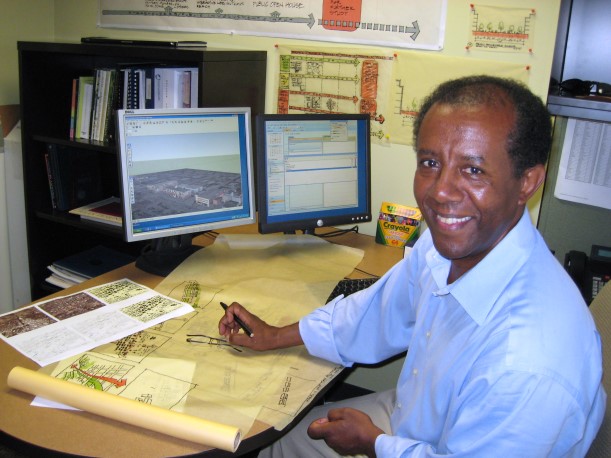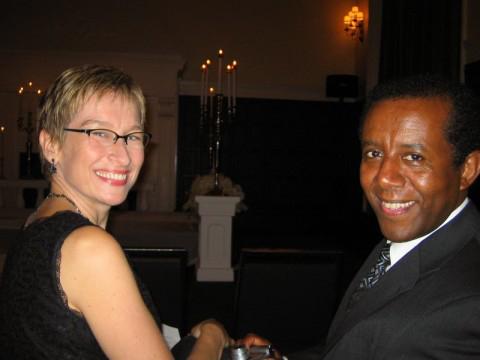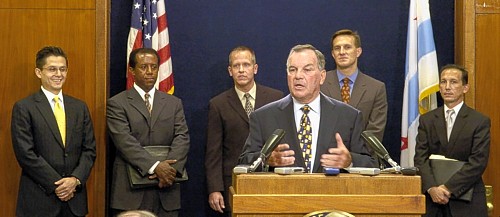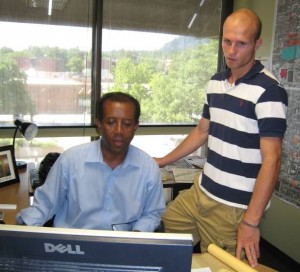Sam Assefa’s journey from Ethiopia to Boulder has shaped Boulder’s new senior urban designer into the soft-spoken, observant, creative, and big-picture thinker that he is. His remarkable story of survival and resilience is more worthy of a profile in the New Yorker than an amateur interview on the Blue Line, but we’ll do our best.
Assefa was born in Addis Ababa to Emperor Haile Selassie’s aide-de-camp, Lieutenant-General Assefa Demissie. Haile Selassie had been a beloved and successful ruler of Ethiopia for most of his life, but a devastating famine, an energy crisis, and an economic crash in the early 1970s combined to create an opportunity for local communists, backed by the Kremlin, to foment unrest. The emperor’s popularity collapsed and the unrest escalated to revolution and a military coup. Several dozen members of Haile Selassie’s inner circle were executed, including Assefa’s father.* Assefa, then fifteen years old, fled Ethiopia shortly after the execution. He escaped with three friends, spending three weeks traveling overland to Nairobi, Kenya. He left believing that he would never see his mother again. “It was a nightmare for my mother,” said Assefa.
The boys had a scheme: Once they reached the Kenyan capital, they would obtain passage to Israel, where, they believed, they could live and work on a kibbutz. They were children thinking in children’s terms about how to survive. They headed to an El Al office in Nairobi and explained their plan to the ticket agent. Something about this particular youngster moved the ticket agent, Terry, into persuading Assefa that he should not go to Israel; he should stay in Kenya and go to school. She invited him to meet her husband and the outcome of that meeting was a scholarship to an international school attended by the children of diplomats and expatriates. Assefa studied at the school with seventeen other children in his graduating class, originating from twelve different countries. To this day, he is still very close to six of his former classmates representing five different countries.
Assefa had always been interested in design and architecture. He was inspired by Frank Lloyd Wright and other architects and wanted to pursue a degree in architecture in the United States, particularly in Chicago. At that time, in the late 1970s, there were no immigration offices in Africa; one had to travel to Europe to apply to come to the United States. With Chicago as his objective, Assefa traveled from Nairobi to Rome. He lived and worked there for more than a year before immigrating, arriving in Chicago in 1980 to study architecture at the University of Illinois. “Nobody told me about the winters,” joked Assefa. It was during this period that he met his wife, Jill Kongabel, a graphic designer and stage actress. The couple has been together for thirty years.
After obtaining his bachelor’s degree, Assefa worked in a small architecture office “doing a lot of expensive homes.” He found the work limiting and his interest in placemaking, environmental issues and social policy growing. He decided to pursue a graduate degree at MIT in city planning. It was there that he met David Driskell, now Boulder’s executive director of community planning. Upon completion of that degree, he was offered a position in a San Francisco architectural firm. Again, he found himself doing design work focused on individual buildings. Still yearning for work in planning and not getting enough of it, Assefa joined the firm of SMWM Architecture and Planning in San Francisco. SMWM is one of the largest women-owned design firms in the country. This progressive organization had policies in place that were revolutionary for a large company, such as never specifying materials that would have an adverse effect on the environment. The firm’s philosophy appealed to Assefa and he worked there, mentored by the firm’s founders, Cathy Simon and Karen Alschuler, for eight years.
In 1999, he was offered a position with the City of San Francisco as a senior urban designer. During the interview for this article, when recounting the events of his personal life, Assefa spoke in a low, barely audible tone, but when describing his San Francisco planning adventures, and discussing planning issues in general, he was much more animated. It was in San Francisco that Assefa got to apply his planning training and get a good feel for how to run a successful public process.
The dot-com boom had put an enormous amount of pressure on San Francisco for housing. The richest residents and a large percentage of the poorest residents were able to find housing, but the folks in between were squeezed out. People were demanding more housing and it wasn’t being built fast enough. Assefa cited an example of a twenty-five-year-old plunking down $800,000 for a shoddily constructed, 800-square-foot unit.
One of the more interesting solutions devised by San Francisco’s planners was to modify the parking policies to require little or no parking for new development. Because a parking space could cost a developer $20,000 to $70,000 to build, unbundling parking from the units dramatically reduced the cost of housing.
As one might expect, there was a great deal of public resistance to this plan. However, in tandem with the parking reductions, measures were implemented to improve the public realm and support downtown living. Sidewalks were made more walkable, an adequate mix of uses was provided, and some auto storage was obtained from businesses that didn’t use their parking lots at night. “Transit first streets” had parking reductions, car storage, car share and reduced housing costs. The result was that transit use increased significantly.
While in San Francisco, Assefa and Kongabel had a baby boy. Tragically, the infant was stricken with a liver disorder and passed away when he was eight months old, after a liver transplant failed. Driskell (whom Assefa had met at MIT) and his wife happened also to be working in San Francisco at the time and supported and shared in the family’s trauma and loss.
Assefa and Kongabel moved back to Chicago, where, in a fascinating reprise of his father’s role as deputy to the emperor, Assefa took a position in Mayor Richard Daley’s office, eventually becoming the director of Land Use and Planning Policy. Assefa speaks very highly of the bold and brash mayor and has a picture of himself and Mayor Daley on his desk. He tells the story of the mayor’s impulse to establish green roofs in Chicago after seeing them in Hamburg, Germany. After first demonstrating that a green roof could successfully be installed on City Hall, Daley turned Chicago into the city with more green roofs than all other cities combined.
During the recent recession, Chicago development came to a screeching halt, and the City responded by reorganizing its planning departments. At about the same time, Driskell was looking to fill Boulder’s senior urban designer position. “It was a great opportunity for us,” said Driskell, about the possibility of recruiting Assefa for Boulder.
The Chicago Tribune sang Assefa’s praises when he left the city, saying that, “The presence of a sophisticated, enlightened official such as Assefa at City Hall was a boon for Chicago’s architectural community. Just as his departure will be a major loss.”
In Boulder, Assefa’s responsibilities include the Boulder Valley Comprehensive Plan update, helping the Boulder Junction (aka Transit Village) planners, taking on special projects such as the Diagonal Plaza, and managing the new Sustainable Streets and Centers project. He will be helping the City look at policies on the built environment and the public realm, addressing questions about appropriate building mass and design character. As a pilot project for the Sustainable Streets and Centers effort, he is starting with Arapahoe Road from Folsom Street to 55th Street. According to Assefa, the “sea of asphalt” along that stretch “doesn’t say ‘sustainable.’” He is managing the process that aims to ask: “What should Arapahoe’s character be? What are the components of design? What elements should be repaired?” He spoke of a “Tale of Two Cities: East versus West of Folsom.”
According to Driskell, Assefa is already having an impact. His office is on the third floor of the Park Central Building, with the other planners and design review teams. “People just pop in and get feedback,” Driskell said, “He brings a wealth of experience with urban design and transit oriented development. He knows the challenges of design and is really wonderful with applicants. Boulder has really complex planning challenges.”
Speaking for himself, Assefa says that “Boulder is a magical place because of its natural setting.” And, “It has to have urban design that is worthy of its natural setting.” Assefa believes that he can bring lessons learned from his other experiences to the job. From his experience in San Francisco, he understands the need to protect the views. He sees Chicago’s protected lakefront as analogous to Boulder’s protected mountain backdrop. Both were established early in the cities’ histories as a benefit for the people, and with a vision that many cities lacked.
He also appreciates the hard lessons. “The public process, with the right tools, will surprise you. People help you look from other than the 10,000-foot level. Planners should be able to say, ‘Yes, you were right, we were wrong.’”
When asked about his motivations, Assefa responded that his passion is placemaking, creating great places, and improving livability. As he travels locally and abroad, he is keenly aware of what he appreciates and what he doesn’t about the built and natural environment. For example, he is enamored of how easily he can get around by bicycle in Boulder. Assefa doesn’t own a car and is hoping to get more people out of their cars. He acknowledges that it is an uphill battle. The outmoded transportation infrastructure and automobile culture is a challenge, but he brings ideas from all over the world to encourage walkable neighborhoods and discourage driving.
When asked, at the end of the interview, whether Assefa ever did see his mother again, he said yes. She comes to visit the United States about once a year. He went back to Ethiopia for the first time in 1995, after a democratic government had been established, and nineteen years after he’d first left. He returns to Ethiopia every couple of years, now. He has also traveled to Nairobi and tracked down Terry, the ticket agent who played such a critical role in setting the course of his life.
*see Bloody Saturday, November 23, 1974 in Historical dictionary of Ethiopia By David Hamilton Shinn, Thomas P. Ofcansky, Chris Prouty, 2004, Lanham, Maryland: Scarecrow Press. pp. 633







 (8 votes, average: 4.75 out of 5)
(8 votes, average: 4.75 out of 5)